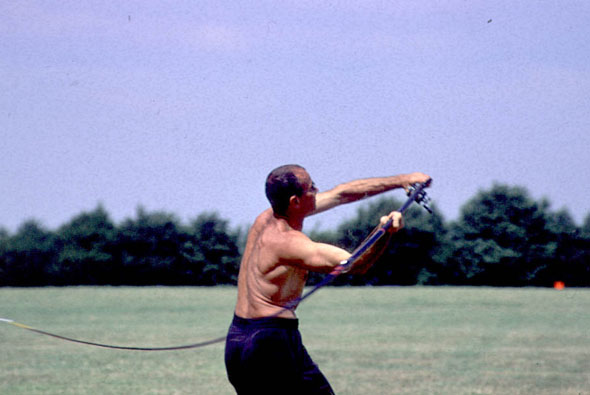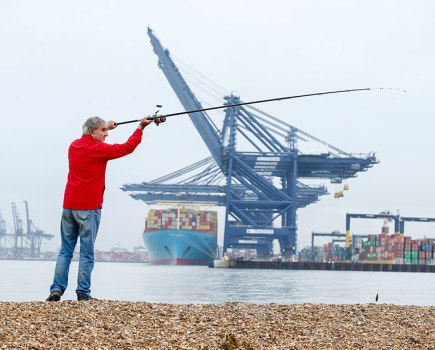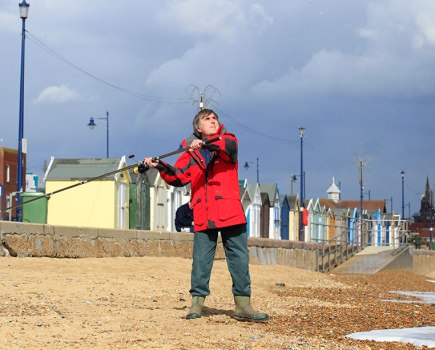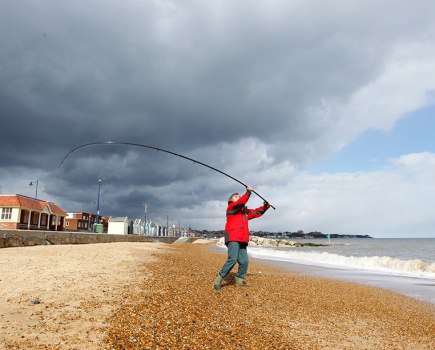Everyone has his own idea about what makes a good cast. One hundred yards is the dream for some; for others nothing less than 200 yards is acceptable, says our casting coach John Holden. At the opposite end of the rainbow are a handful of ever-hopefuls who would be over the moon with a couple of casts that managed to land in one piece
What I find most encouraging is the down to earth view of the majority of anglers I meet. Common-sense is the key. It is a huge mistake to imagine that everybody who picks up a beach outfit is hell bent on stardom.
We dream about tournament records, buy rods that we know we’ll never bend, but we’re neither daft nor deluded. More tournament rods are owned to be bragged about than will ever be used day after day in the quest for monster distances.
Here in the real world, the most popular target is around 150 yards with baits. “If I could do that without too much effort,” one caster told me, “it would be the dog’s bollocks! I wouldn’t feel an idiot in front of my mates who can cast a bit.” Probably millions of beach anglers around the globe feel the same way.
Which of these casts is best? Two hundred yards over grass with a 150g sinker, 0.31mm line and no baits; casting 4oz the same distance on 18lb level line (no shock leader); fishing a cod beach at 150 yards with 175g sinker, 0.35mm line and a three-hook rig baited with lug, or one hundred yards into a headwind from a slippery rock platform, seven ounces of lead, half a mackerel, 35lb mainline on a big multiplier without magnets or brake blocks… and wet hands.
In the great scheme of things, they are all excellent. On a personal level, though, they are not equal. It is what casting means to you that makes the difference. For me, 200 yards level line is the most satisfying as a cast, pure and simple. Slinging a mackerel off the rocks would certainly be a bigger challenge, but as far as I’m concerned you can keep it.
Where does good casting begin?
The magic figure has grown over the years: 80, 100, 150, 200 yards. There is a balance to be struck. On the one hand, whatever distance makes you happy is far enough. On the other, most of us need some target in mind if only as a yardstick for charting our progress.
The big mistake for an angler – as opposed to a tournament caster, who is a completely different animal – is to focus on distance as the only factor worth talking about, and the only true measure of success.
Yardage does tell you whether the basics are right. About 100 yards suggests that you’re beginning to get a feel for the game, especially if you can average that without too much effort. Turning up the heat a little, around 150 yards is an excellent target for beach fishing.
This is equivalent to 175 yards or so over grass, and is long enough to prove that you really have mastered the basics of good casting. It also remains a realistic goal for an angler who lacks the time and maybe the inclination to dedicate himself to thrashing away on a field when he would rather be drowning baits. As a practical maximum fishing range it is just about perfect.
Fish are caught much further out, but on beaches world-wide those ultra-distance catches are few and far between. How many hours would you be prepared to devote to casting practice if the pay-off amounted to a handful more fish in a season?
Whatever the effort required to hit top distances on the beach, it is nothing compared to the demands of tournament casting. The biggest injustice ever done to tournament casting is to underestimate the sheer grinding slog of practice, practice, practice, day in, day out, year after year that leads to the top division.
World records are an awesome mix of talent and determination every bit the equal of Olympic gold, in field events such as hammer and javelin. Casting for long-range cod isn’t in the same league, not even on the same planet.
So why go through the agonies of comparing your efforts with tournament records, or struggle with the high performance kit that some match experts advise? Why spend a fortune in tackle and waste months on the field if the result is more distance than you will ever need for fishing? Go fishing instead.
But if you do get bitten by the casting bug, give it 100 percent even if it does mean ducking out of the odd beach trip in order to polish up your chances. Excellence always comes at a high price – and yes, it involves some difficult decisions. Learn the rules before you play the game.
Setting your personal baseline
Whether you aim to catch 80 yard flounder or be the first to 400, your starting point is the same: It is how far you cast now, full stop. This baseline average distance is neither good nor bad. It has no bearing on how far you are capable of casting. How far you are capable of casting has little bearing on how far you will actually end up casting. Lack of time prevents so many of us from reaching our full potential.
If casting is merely a tool for fishing, then you will be happy when you can cast far enough to achieve good catches, whatever that distance might be. For those of us who cast because we enjoy it for its own sake as well as for its angling benefits, casting is a game of unfulfilled promise.
No matter how far you cast, you always want a little bit more. Or indeed, a whole lot more. It’s up to you – far enough, or further. Choose the target that makes more sense to you.
Measure a dozen casts without baits. Work over grass if you can. Be sensible in picking out the casts to count: Ignore the occasional extra-long cast in the same way as you would reject those that fall far short. The average distance is your baseline.
If you use different sinker weights and outfits for various kinds of fishing, measure them individually. It is useful to see the difference between a baited rig and sinker alone. The key distance for all-round beach work in the UKis how far you average with around five ounces (150g) and line in the 15lb (0.35mm) bracket – the category of beach tackle likely to produce maximum control and distance for most anglers.
First goal – the same, but easier
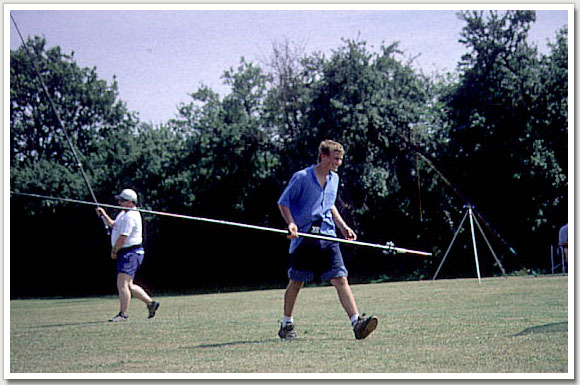 Being able to cast 150 yards is the equivalent of sending a sinker 175 yards over grass
Being able to cast 150 yards is the equivalent of sending a sinker 175 yards over grass
Begin your venture into better casting by doing your present distance with more control and minimum effort. Usually it is a matter of revising or radically altering some aspect of technique.
Compared to a thump with a low inertia sinker position, for instance, the Easy Cast and semi-South African throw the same distance with much less effort. We looked at those two methods last month. They are built on simple exercises from earlier in the series.
Thrashing for extra distance gets you nowhere. Better distance is the automatic by-product of casting properly. Aim for a straight, smooth and relaxed cast with plenty of height. Another tell-tale sign of good basic technique is sinker weight versatility. You should be able to throw four ounces just as comfortably as the usual five. Six or 8oz should not overwhelm the system.
The pressure and timing will vary between weights. That is normal, just as it is normal not to enjoy casting certain weights.
At this stage it is not a question of whether you like it, but whether you can do it. If you cannot, the foundations of technique are weak.
Easy work or hard graft
Brushing up on technique should soon have you achieving your original average with much less trouble and effort. Feedback from the rod will confirm that things are running much more smoothly now; and of course you won’t feel yourself straining so hard.
Had you been struggling to average 80-100 yards, this baseline distance should now be coming up with around half the apparent effort. Were you already on 150 yards, the reduction in effort will be less because your original technique was already quite sound. But you will notice a big improvement in control and timing. The quick, thrashiness should have disappeared, replaced by a smooth action that seems much slower.
Now you can afford to dial in a bit more power. Add a spoonful at a time, not a bucketload.
Provided that the technique stays sound, distances will creep up with no loss of control nor sense of wasted effort. Afew extra yards is a great result. Stop increasing the power when you feel the cast beginning to get ragged. Go back to the point just before that. Measure the average distance this produces and treat it as your new baseline.
Next session, put a peg in the ground about ten paces less than the new baseline. Now see how easily and smoothly you can land the sinker beyond the peg. You know that you can cast further, so this is a game without pressure. Develop that easy, relaxed action where the rod seems to be casting itself.
For the last few casts, raise the power a tad. If distances go up, fine. If not, no need to fret. Depending on many different factors, you might end session after session having cast very little further. This is where persistence pays off. Stay focussed on the basics, stay confident, and be patient.
The good news is that at some stage you will enjoy a sudden boost. Those extra yards come right out of the blue. It’s hard to say why distance improves in steps like this, rather than in smooth progression. One moment you’re on, say, 125 yards, next cast it has gone up to 140. The oddest thing is that nothing feels different. Better still, improvements gained this way invariably turn out to be permanent.

